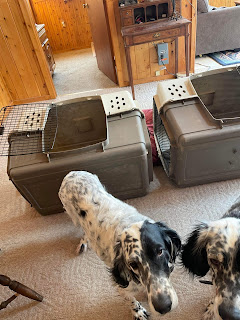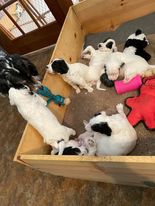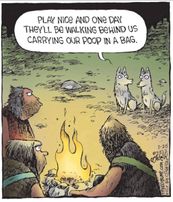By Randy Lawrence
Whelping a winter's litter, like many things in life, is a great idea...
...in theory.
Puppies weaned in March have plenty of time to get their legs under them and a few manners laid over them before being gently introduced to thoughtfully arranged field work come autumn. In a sense, it's stealing a march from tempus which, for those of us who measure our own lives, in part, by those of our dogs, fugits far too rapidly.
But there's a price to be paid, especially in the freezer section of Michigan, where, last night, the temperatures sagged to -20 degrees. Where Lynn Dee lives, winter whelping is an indoor sport and ongoing adventure and not for the faint of heart or fussy of olfaction.
Lynn Dee's home is ingenuously arranged around her dogs. At no time is that more apparent than during puppy rearing. Still, tending the whelping arena is not a stand-alone activity. Lynn Dee has a half dozen adult dogs sharing her digs, each of whom is convinced that he or she is every #%*&@ bit as special as Annie and her pups. Just last week, a breeding female emeritus who shall remain nameless (but whose initials are "Firelight Kate") signaled that she'd had enough of being a bystander to all the focused hullabaloo. Her response was to decorate the Other Dogs' Lounge with the contents of her own dog bed...just to remind Lynn Dee that SHE was not far removed from Center Stage.
Beyond juggling the egos of other Firelights, who've been reminded every day of their lives of how special each one is, a winter brood requires extra everything: extra heat, extra litter box materials, extra clean-up. Not just once in a while, but pretty much around the clock. After all, there is a balance between intake and outgo. Puppies poop.
Even the most conscientious breeder who seldom pauses the pickup has to sleep sometime. Lynn Dee confessed to me today that puppy-tainted air makes it hard to enjoy the cup of morning tea needed to gird her loins for biohazard clean-up so is thankful that she can simply close their door for that respite. The utility room washing machine with loads of puppy bedding seems to churn around the clock…
…that is until the fitting over one of the water pipes cracks and starts calling Noah to commence ark building late one night.
By a turn of good fortune, Lynn Dee was still up, tending to things. She heard water running where and how water is not supposed to run, ran in to find flood waters gathering, then had the presence of mind to hit the conveniently located breaker switch to the water pump, then grabbed towels to dam up the utility room to prevent a whole-house-and-puppy-room tsunami.
Disaster averted…but had Lynn Dee already been to bed where she would not have heard that ominous splish-splash…
Next morning, luck continued to smile on Firelight fortunes in the form of a plumber who just happened to be coming up that way for the annual Sno*Drift Rally performance car race. He said he could do the repair later that day. Meanwhile, Lynn Dee surveyed an innocent bystander to cracked pipe crimes, her aged washer, and decided it was long past time for an upgrade. A quick trip to town, and a new machine was on the way. Before one could say “Soiled Puppy Bedding Meets The Local Laundromat,” cleanliness, godliness, and order was restored to Firelight HQ.
("Down The Slide": Edmund Henry Osthaus)
But that's just one bit of anecdotal evidence that shows why a winter litter requires more from the breeder. Understand, too, that indoor accommodations must be continually expanded to provide secure, spacious footing for a veritable 32-legged crime wave. There is a soft vinyl floor covering protecting the carpet in the puppy room; every time the Puppy Corral is re-configured, or the vinyl simply “walks” away from the wall given riotous puppy romping, the flooring has to be moved along with the converted whelping bin, the litter boxes, the Blue Battle Bowl (more on that later)…
To do all that requires someplace to stash puppies. “I found that side door crates make wonderful temporary puppy crates,” Lynn Dee says. “I lay bedding on the side/bottom for them and with the door open on top, they can’t escape as I take them in and out.”
When all is back in place, the games can begin all over again.
With each passing week, Lynn Dee adds creative ways to keep puppies stimulated with purpose-built playpen gear. This week, sections of plastic chain dangle toys of all sorts into the puppy arena. The Battle Royale For The Blue Bowl has been an exciting addition to puppy play. The heavy duty bowl rocks and rolls as different individuals commandeer it for as long as possible.
During quiet times (and there are some), Lynn Dee is constantly lifting puppies out of their den for one on one time, constantly socializing them with her voice, soothing background music and her schedule. Nothing about this nurturing environment is left to chance in molding healthy, confident gun dog prospects. Even in the dregs of winter, at Firelight HQ, autumn is always calling.
("Priscilla" by Edmund Henry Osthaus)

























